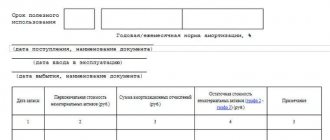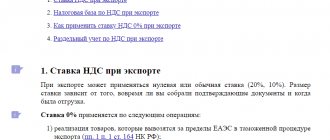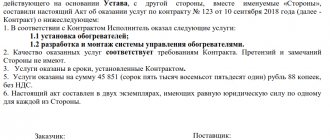What is this in accounting?
According to PBU 9/99 “Income of the organization”, revenue is recognized as income from ordinary activities - revenue from the sale of goods or products, as well as receipts that are associated with the provision of services and performance of work. In accounting, revenue does not mean any income from sales, but only income from the main type of activity, while the remaining income is recognized as other income (we talked in more detail about how revenue differs from income and other accounting concepts here).
Reference! In organizations in which the main subject of activity is the provision of assets under a lease agreement for temporary use, revenue is rent receipts.
In accounting, revenue is recognized subject to the following conditions:
- revenue can be determined in terms of value;
- the organization has the right to receive this revenue;
- as a result of the operation, the economic benefits of the company will definitely increase;
- the property rights to the product (goods) have been transferred to the buyer or the work has been accepted by the customer (service has been provided);
- the costs of this operation can be determined.
That is, revenue is considered an increase in economic benefits , which leads to an increase in the assets of a given organization. Often, revenue is recognized without actual cash receipts (accrual basis). But small businesses have the opportunity to record revenue using the cash method - when funds are received. Read this material about what to do when proceeds from a buyer are credited to your bank account or cash register.
To record revenue in accounting, account 90 “Sales” is used (we tell you more about which accounting account revenue is displayed on here). Sub-accounts are opened for account 90:
- subaccount 90.1 – records are kept of receipts considered revenue;
- subaccount 90.2 – the cost of sales is recorded (what is the difference between the concepts of “revenue” and “cost” read here);
- subaccount 90.3 – records of VAT amounts are kept;
- subaccount 90.4 – records of excise tax amounts are kept;
- subaccount 90.9 – necessary to reflect the financial result of the organization’s sales for the reporting month.
Revenue calculation
Quite simple formulas are used for calculations. It is enough to know the volume of products sold over a certain period of time and the unit cost, then multiply them. Next, the obtained values for each group of goods are summed up. It is worth noting that funds received during the operation of the enterprise are not included in revenue.
The formula looks like this:
TR = P * Q, where
TR – revenue, rub.;
P – price, rub.;
Q—sales volume, units/pcs.
For example, let's calculate the revenue of the Vesna store from the following products:
- Tea - 23 packages sold, each cost 105 rubles.
- Sugar – 3 kg, 40 rubles each.
- Lemon – 1 kg, cost – 200 rubles.
- Revenue for tea was – 23*105 = 2415;
- Revenue for sugar – 3*40=120;
- Revenue per lemon – 1*200=200.
The store's total revenue for this group of products was 2415+120+200=2735 rubles.
If a product was initially sold at one price, and then its value increased, then revenue is calculated for each product depending on its cost, and then added up.
For example, at the beginning of January, 120 packs of tea were brought to the Solnyshko store for 105 rubles, and in February another 76, but with a cost of 110 rubles. At the same time, there are still 20 packs of tea left in the store at the old price.
Within a month, the remaining 20 packs and 34 packs from the new batch were sold. Thus, the revenue for the sale of tea in February will be: (20*105)+(34*110)= 2,100 + 3,740 = 5,840 rubles.
The data obtained during the calculations is considered information for internal use and is not included in the financial statements.
However, once a quarter or a year, these indicators are calculated by an accountant and recorded in the “Profit and Loss Report”. In this case, the amount of revenue without indirect taxes and VAT is indicated (see also how to calculate VAT). In addition , in some cases, the amount received during the sale may not entirely belong to the company. For example, when selling consignment items, the seller receives proceeds from the buyer, the main part of which belongs to the owner of the goods.
For example, the Solnyshko consignment store accepted the following items for sale with the proviso that the people who provided them or the consignors would receive the following amounts:
- Children's chair - 450 rubles.
- Manege - 890 rubles.
- Kangaroo – 500 rubles.
The store sellers also added a 20% markup on the goods, that is, the final cost of the items was: 540, 1068 and 600 rubles, respectively. After the sale of these items, the profit of the Solnyshko store was:
(540+1068+600) – (450+890+500) = 2,208 – 1840 = 368 rubles. The remaining amount, according to the previously drawn up agreement, will be received by the principals.
The reports prepared by the accountant are provided to the company's management. Based on them, conclusions are drawn about which goods are in greater demand and which are in less demand. Consequently, this helps to shape the volume of purchases of a particular product.
In what documents is this amount reflected?
To reflect revenue from the sale of products (performance of work or provision of services) in accounting, it is necessary to have documents that confirm the transfer of property rights to these products to the buyer. Sources of information about the company’s revenue are the following documents:
- Source documents:
- contracts with clients for the sale of products, services and works;
- waybills;
- invoices;
- invoices for delivery of finished products;
- requirements for product release;
- warehouse cards;
- log of received and issued invoices;
- sales book;
- invoices for the sale of finished products, bills of lading, cargo customs declarations;
- turnover sheets, quantitative and total cards;
- certificates of services rendered or work performed.
- Analytical and synthetic accounting registers:
- main book;
- order magazines No. 10, No. 11 and No. 15;
- statement No. 16.
Postings
In an organization's accounting, revenue is reflected at the time of its recognition - that is, at the time of transfer or shipment of products. The exception is transactions under contracts that specify the specifics of the transfer of property rights. When selling products to wholesale customers, the following transactions are recorded:
- D 62 K 90.1 – revenue from sales of goods or provision of services was reflected;
- D 90.2 K 41 – the cost of goods sold or services provided is written off;
- D 90.3 K 68 – VAT is charged on the cost of goods sold or services provided;
- D 51/52 K 62 – payment received from the buyer to a current/currency account.
Posting to retail revenue at the cash register can be done directly with account 90 “Sales”, since there is no need to keep records of settlements with retail customers on account 62 “Settlements with buyers and customers”, since payment and shipment are made simultaneously: D 50 K 90.1 – revenue from retail sales was taken into account.
According to the Instructions for using the Chart of Accounts, to reflect cash transferred for collection, posting to account 57 “Transfers in transit” is used:
- D 57 K 50 – cash was issued to the bank’s collection service (you can learn about the procedure for accounting entries when depositing proceeds with the bank here).
- D 51 K 57 – cash was credited to the company’s current account.
Step-by-step instructions for recording in accounting
When reflecting revenue in accounting, the following entry is used: D 62 K 90.1 – revenue from the sale of finished products is reflected, the products are shipped to the buyer (work is performed or services are provided).
Simultaneously with this operation, the cost of production is written off. If an organization accounts for finished products at actual cost, then the write-off is reflected by the following entries: D 90.2 K 43 - products written off at actual cost .
If an organization keeps records of finished products at planned (standard) cost, then the write-off is reflected in accounting in the following way:
- D 43 K 40 – finished products are accepted for accounting at planned cost.
- D 90.2 K 43 – finished products are written off at planned cost.
- D 40 K 20 – actual cost is reflected (at the end of the month).
- D 90.2 K 40 – deviations of actual from standard costs (overexpenditure) are written off.
- D 90.2 K 40 – reversal: deviations of actual and standard costs are written off (savings).
Important! The cost of services provided or work performed is not reflected in account 43 “Finished products”, and the actual costs for them are written off to account 90 “Sales” from the production cost accounts. - D 90.2 K 20 – costs for services/work are written off.
Checking proceeds from sales not subject to VAT (not UTII)
This line reflects sales that are not subject to VAT in accordance with Art. 149 of the Tax Code of the Russian Federation, for example:
- sale of medical goods;
- warranty repair;
- transfer of goods (work, services) free of charge as part of charity, etc.
In the Universal report to check the amount in the line
- not subject to VAT (not UTII)
In the header of the report please indicate:
- Period —the period for compiling the report;
- Accumulation register - type of data source;
- VAT Sales - the report will be generated according to the VAT Sales ;
- Revolutions — data for creating a report.
Click the Settings in the report header to open the settings panel, click the View – Advanced .
Specify on the Selection :
- 1st line (if accounting is kept for several organizations in the database): Field - Organization ,
- Condition - Equal to ,
- Value - the name of the organization for which you are generating the report,
- The way to display the selection field is asterisk, i.e. show it in the report header.
- Field - VAT rate ,
- Field - Type of value ,
- Field - Event ,
On the Fields and Sorting , specify the fields that will be displayed in the columns of the tabular part of the report.
On the Structure , set the set of grouped fields and the order in which the table section headings will be displayed in the report.
Please indicate:
- Organization (if records are kept for several organizations); Detailed entries .
After completing the settings, click the Close and Generate . The program will generate a report according to the form specified by the settings.
Taxation
Operations for the sale of products (services or works) on the territory of the Russian Federation are objects of taxation, which means that the organization (if it is a VAT payer) is obliged to charge VAT on the sales amount, according to Art. 146 of the Tax Code of the Russian Federation (we talk about what is considered revenue from sales in a separate material). The moment of accounting for the tax base is the earliest of the following dates (Article 167 of the Tax Code of the Russian Federation) :
- day of transfer/shipment of goods (provision of services or performance of work);
- the day of payment or prepayment for future deliveries of goods (provision of services or performance of work).
If the moment of determination of the tax base is set on the day of payment or prepayment for future supplies of goods (provision of services or performance of work) or on the day of transfer of ownership rights, then the moment of determination of the tax base arises on this day (Clause 14 of Article 167 Tax Code of the Russian Federation).
In some cases, the determination of the VAT tax base may not correspond at all to the moment the proceeds from the sale are accrued.
If the contract provides for the transfer of property rights at the time of transfer of goods, proceeds from the sale are recognized at the time of shipment , therefore, the moment the VAT tax base is determined is recognized on the same day.
Reference! The amount of VAT receivable from the buyer (client) is recorded in subaccount 90.3 “VAT”.
To reflect the tax on the day of shipment, the following entry is made in accounting: D 90.3 K 20 - VAT is charged on the proceeds from the sale.
If the contract stipulates that the transfer of property rights occurs at the time of transfer of goods, and the goods are shipped on an advance payment basis, then revenue is accounted for at the time of shipment . In this case, the moment of determining the tax base for VAT is the moment of prepayment against future supplies of goods.
In this situation, the moment of determining the VAT tax base has already arrived, but revenue has not yet been recognized in accounting.
At the time of shipment, revenue is recognized and the tax base is determined again. VAT will be reflected on the day of shipment . And now VAT on the amount of payment or prepayment received on account of future supplies of goods (services or work) is subject to deduction.
Revenue is the most important element demonstrating the effectiveness of the company's financial results. The importance of revenue is proven by the fact that the amount of taxes paid by the enterprise - starting from VAT and ending with income tax - depends on the accuracy of its reflection in accounting.
In the event of an accounting error, the company expects incorrect readings in the annual financial statements and problems in interaction with the tax authorities. In this regard, it is necessary to pay a lot of attention to keeping records of revenue and avoid making mistakes.
We talked about how accounting records revenue with and without VAT in a separate article.
Types of revenue
Revenue from the sale of products and services is funds received for products or services shipped to customers. Revenue of this type is divided into two types:
- Gross , which takes into account all funds received for a product or service. In the case of barter payment - the full cost of the exchange agreement. This amount includes not only taxes, but also various fees and duties, which are then paid to the state. The second name for this type of revenue that can be found is net revenue.
- Net is the difference between gross revenue, taxes and excise taxes. Recorded in the profit and loss statements of the enterprise. Net revenue is also called gross revenue. It is this that forms the main income of the enterprise.







